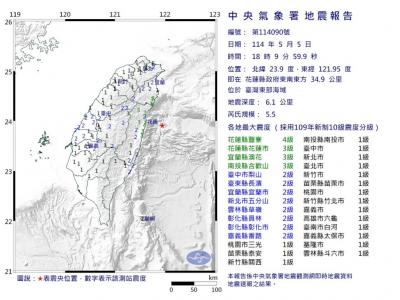The population of Taiwan’s critically endangered Formosan landlocked salmon has reached a record high of more than 15,000, an annual survey by Shei-Pa National Park showed.
The endemic subspecies of salmon, a “glacial relict” left in Taiwan after the last ice age, is found only in freshwater streams at elevations higher than 1,500m.
The number of endangered species in Taiwan is estimated at 15,374, with large populations in Cijiawan Creek (七家灣溪) and Hehuan Creek (合歡溪), and smaller populations in Luoyewei Creek (羅葉尾溪), Arikatsu Creek (有勝溪), Nanhu Creek (南湖溪) and Bilu Creek (畢祿溪), the survey showed.

Photo courtesy of the Shei-Pa National Park Administration
The salmon is now found in many tributaries along the upper reaches of the Dajia River (大甲溪), with its habitat in the 1970s extending to about 80 percent of the range, the park office said in a statement on Wednesday.
The office’s first survey of Formosan landlocked salmon in 1995 showed that the species was close to extinction, with a population of about 200 in the Dajia River basin.
The population began to gradually recover after a conservation program was established, surpassing 5,000 in 2018 and 10,000 in 2019, the office said.
National park officials plan to work on several remote streams in the Central Mountain Range in October in an effort to release more Formosan landlocked salmon, it said.
That procedure once involved taking juvenile salmon, known as fry, to the release points in bags of water — a method that limits the number of salmon that can be carried, and puts them at risk of oxygen starvation, the office said.
Given advances in conservation techniques, the salmon this year can be released in their “eyed egg” stage — as fertilized eggs less than 30 days old that have visible eye spots — thus improving their chances of survival, the park office said.
Formosan landlocked salmon typically grow to about 30cm long. The species is depicted on the back of the NT$2,000 bank note.

An essay competition jointly organized by a local writing society and a publisher affiliated with the Chinese Communist Party (CCP) might have contravened the Act Governing Relations Between the People of the Taiwan Area and the Mainland Area (臺灣地區與大陸地區人民關係條例), the Mainland Affairs Council (MAC) said on Thursday. “In this case, the partner organization is clearly an agency under the CCP’s Fujian Provincial Committee,” MAC Deputy Minister and spokesperson Liang Wen-chieh (梁文傑) said at a news briefing in Taipei. “It also involves bringing Taiwanese students to China with all-expenses-paid arrangements to attend award ceremonies and camps,” Liang said. Those two “characteristics” are typically sufficient

A magnitude 5.9 earthquake that struck about 33km off the coast of Hualien City was the "main shock" in a series of quakes in the area, with aftershocks expected over the next three days, the Central Weather Administration (CWA) said yesterday. Prior to the magnitude 5.9 quake shaking most of Taiwan at 6:53pm yesterday, six other earthquakes stronger than a magnitude of 4, starting with a magnitude 5.5 quake at 6:09pm, occurred in the area. CWA Seismological Center Director Wu Chien-fu (吳健富) confirmed that the quakes were all part of the same series and that the magnitude 5.5 temblor was

The brilliant blue waters, thick foliage and bucolic atmosphere on this seemingly idyllic archipelago deep in the Pacific Ocean belie the key role it now plays in a titanic geopolitical struggle. Palau is again on the front line as China, and the US and its allies prepare their forces in an intensifying contest for control over the Asia-Pacific region. The democratic nation of just 17,000 people hosts US-controlled airstrips and soon-to-be-completed radar installations that the US military describes as “critical” to monitoring vast swathes of water and airspace. It is also a key piece of the second island chain, a string of

The Central Weather Administration has issued a heat alert for southeastern Taiwan, warning of temperatures as high as 36°C today, while alerting some coastal areas of strong winds later in the day. Kaohsiung’s Neimen District (內門) and Pingtung County’s Neipu Township (內埔) are under an orange heat alert, which warns of temperatures as high as 36°C for three consecutive days, the CWA said, citing southwest winds. The heat would also extend to Tainan’s Nansi (楠西) and Yujing (玉井) districts, as well as Pingtung’s Gaoshu (高樹), Yanpu (鹽埔) and Majia (瑪家) townships, it said, forecasting highs of up to 36°C in those areas